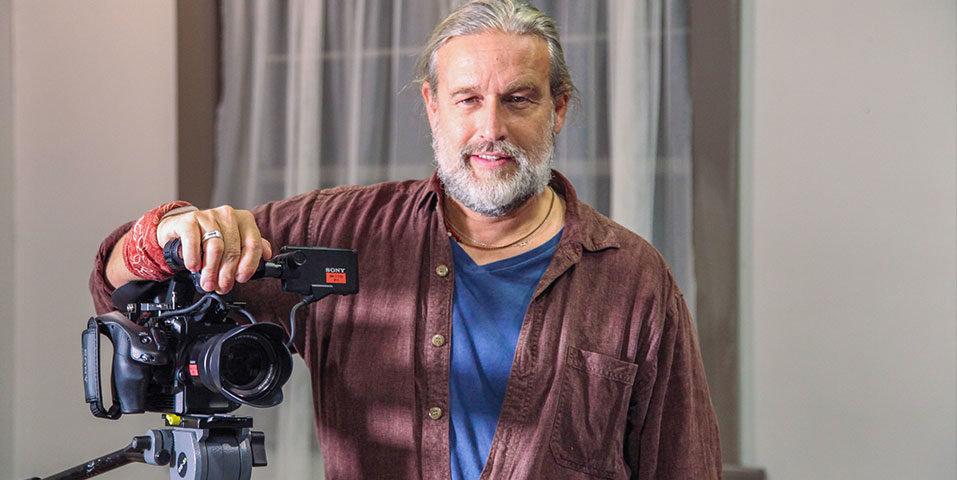Videomaking Intensive: Shoot, Edit, Publish, one of AFTRS’ most sought-after short courses, taps into essential learnings for those wanting to improve their visual storytelling skills and elevate their content.
We sat with cinematographer and expert tutor Gareth Tillson to learn what makes this course unique and how students are trained holistically: from understanding camera and editing skills, interviewing, constructing scenes and creating a rough cut with basic audio mix, to graphics and colour correction.
Video is compelling asset to convey complex messages, layering opportunities to connect with the audience by telling a story and sharing brand values. This rounded introduction to video production unlocks the capacity to impact and enhance communication, build an online presence and brand reputation, or expand video production capabilities for those already creating content in other formats.
An established cinematographer, Gareth has shot shorts, documentaries, commercials and music clips, and his debut feature, LBF, premiered at SXSW Film Festival in 2011. Here’s some of Gareth’s inside knowledge on the course delivery and main takeaways.
What do you find inspirational about teaching the Videomaking Intensive course?
“What I find inspirational is the people doing the course to upskill. There are a lot of people who already have photography or editing skills and some who work in production and want to expand their craft to deliver from idea to output. There’s also an increased need for people to be multi-skilled; there’s so much need to create at various levels and to deliver different outputs that having that extra bit of knowledge can be extremely useful.”
Can you share a bit about your background in videomaking and how it shapes your approach to teaching?
“My film and video background is in cinematography, so visual storytelling is what I’m most interested in. The visual side of video making has several levels, and the first level is technical, making sure that exposure, focus and other technical requirements are correct. But beyond that is the creative. The creative is where we want to get to. The technical is just a tool that allows us to be creative.
In video making and visual storytelling, what is increasingly important is the juxtaposition of images to create stories. And that’s the key. That’s what I work the hardest on, and I’m most concerned that people understand how to tell a visual story with a flow that enables the audience to follow and remain engaged.”
The Videomaking intensive is structured across five days, can you share an overview of the learnings and hands-on experience on each day?
“The first two days are based at AFTRS, and the students are learning technical skills. They learn how to set and put the camera onto the tripod and what the camera does when shooting automatically or manually. Then, students continue to learn about recording sound, different microphones, and checking and setting sound levels. Once there is a technical understanding of the tools, we do exercises in interviewing and develop the soft skills for doing an interview.
The work we do on the first two days is preparing for a shooting exercise, which is usually in Centennial Park for 3 hours on the Wednesday morning. That’s where we shoot a little story that we will edit in the second half of the week. Wednesday afternoon is dedicated to wrangling and importing the files to the editing software.
The last two days are focused on editing, putting the stories together, and building the narrative. By Friday, students have a rough cut and have familiarised themselves with Premiere Pro through a series of mini tutorials and hands-on exercises that look at specific tools of the software. We look at transitions, effects, audio editing, audio mixing, titles, graphics and colour grading so that we have a relatively polished video at the end of the week.”
Is the Videomaking Intensive a good introduction for students wanting to learn the basics of filmmaking?
“Video making is an excellent introduction because it touches on all the bases, from pre-production and organising thoughts, intentions, and resources to forming and executing a plan. There is a need to structure these elements before collecting pictures and audio to create engaging video narratives. Students complete the course understanding how to take this process from 0 to 100.”
What’s the most exciting or unexpected thing someone has created in or after taking your course?
“It is remarkable how many stories we can get out of one location. In the Videomaking Intensive course, we often shoot in Centennial Park, and the number of stories being told in that park makes me realise that there’s an unlimited number of stories to tell.
I’ve certainly learned a lot about the park, its history, its natural elements, and other things that I didn’t know. Interestingly, the tools I’m giving the students are the technical ability to get the video, the audio, and the interviews so they end up with a story. Their story is the reason why we are there sharing knowledge.
Some students can marvel at how good a camera is and the technical aspect of every detail in the process, but in the end, it’s about creating a story and connecting with a story, and that’s what makes it worthwhile.“
Sound like the course for you? Learn with Gareth how to create professional quality short videos through hands-on experience with our Videomaking Intensive: Shoot, Edit, Publish.
